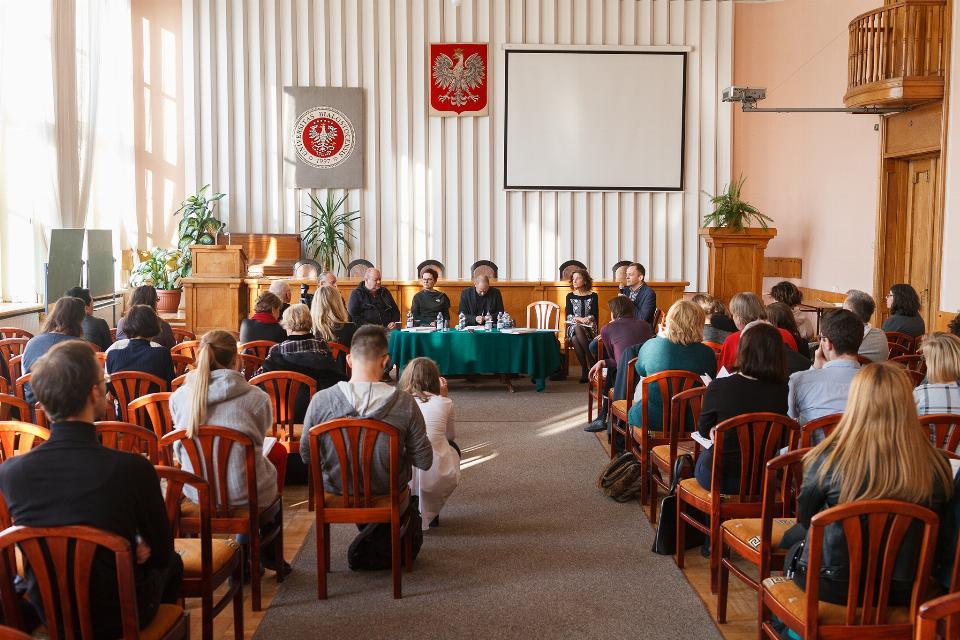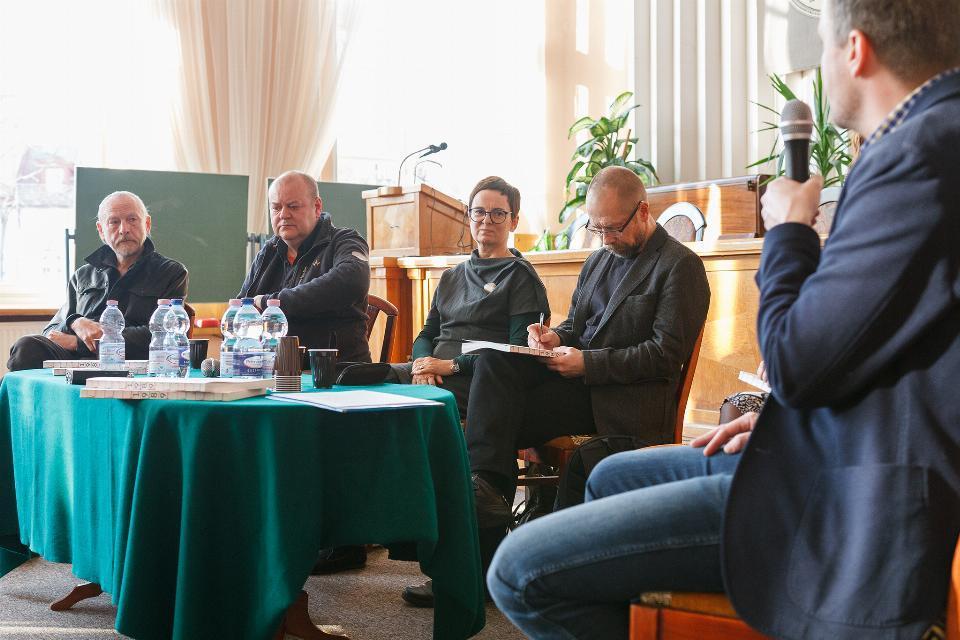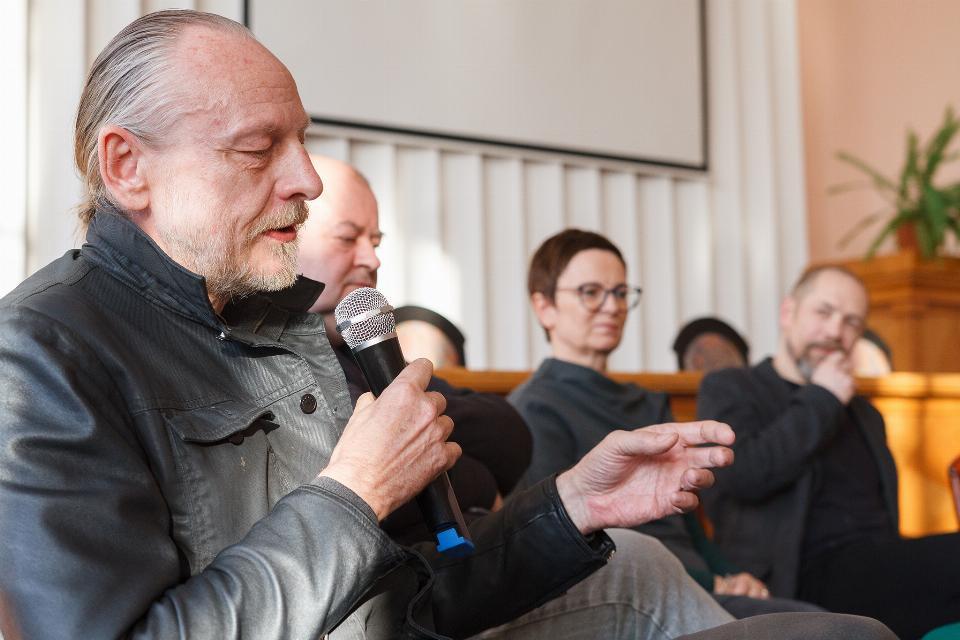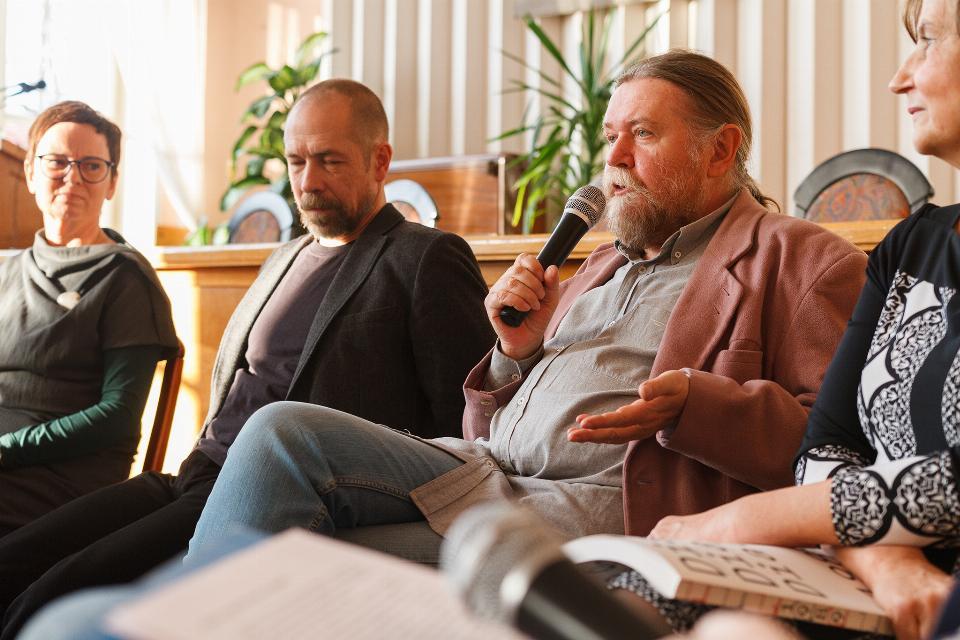Panel discussion accompanying “Dialogue | Engagement Through Culture Before and After 1989” exhibition
Galeria Arsenał invites to a panel discussion accompanying “Dialogue | Engagement Through Culture Before and After 1989″ exhibition featuring Prof. Przemysław Czapliński, Prof. Ingi Iwasiów, Grzegorz Wróblewski and Andrzej Jagodziński, Antonina Krzysztoń and Zbigniew LiberaHosted by: PhD. Marek KochanowskiWednesday, 10.04.2019, 18.00Faculty of Philology at the University of BialystokFree entryThe project is co-financed from the funds of the “Europe for Citizens” programme
A Culture Involved, Pre- and Post-1989
Przemysław Czapliński wrote of the year 1989 in Ruchome marginesy [Moving Margins]: “Things were meant to be different. Great, diversified, breakthroughs and suchlike. Such were expectations raised in the wake of 1989. Whereas – according to current data – culture and watershed literature inexplicably morphed into mass culture, its format far from magnificent. Brings the old joke to mind: ‘Planned for champagne and caviar, got vodka and cucumbers’.”[1]
1989 was the breakthrough year for Poland after World War Two, its advent announced by cultural harbingers from 1986 onwards: Adam Zagajewski’s Solidarność i samotność[2] was published in Paris; Cracow began publishing the bruLion; the Orange Alternative movement raised its head in Wrocław. The press began teeming – voices of i.a. Tomasz Burek, Rafał Grupiński, Tadeusz Komendant clearly audible – with discussions concerning the most effervescent issues of obligations carried by our literature and writers’ involvement, both dating back to 1918. In poetry, the dispute was most powerfully verbalised in Marcin Świetlicki’s well-known piece “Dla Jana Polkowskiego” [For Jan Polkowski] (1988), wherein the author propositions poetry of personal experience instead of poetry involved. The importance of these polemics was emphasised in and by titles of successive critical interventions, such as Jan Błoński’s essay “Rok 1989 jest równie ważny co 1918” [The year 1989 is as important as 1918], published in the NaGłos periodical in 1990. And a lot was going on indeed: successful debuts (i.a. by Jerzy Pilch, Andrzej Stasiuk, Olga Tokarczuk), new periodicals (the aforementioned bruLion included), television programmes, literary disputes (the classics and barbarians), the TotArt formation of the TriCity. Notably, prior to 1989, the so-called “secondary stratum” of independent, uncensored literature had been accompanied by an explosion of a “tertiary stratum” (artzines) and alternative culture. The 1980s are also a time of a growth of rock music, and complementary development of subcultures of the young.
While 1989 was an important year politically, literature became an expression of individual disappointment with freedom, the sensation enhanced by the collapse of the myth of Solidarity: a sense of disintegration became the vital experience of participants in culture at the turn of the 1980s and 1990s. 1989 events demanded that multiple notions – including culture, in its martyrologically affected version in particular – be redefined. The time of collective, national, and symbolic activity was over; visions of literature changed; freedom brought an element of critical ponderings of tradition – suffice to mention “Kres paradygmatu” [The End of a Paradigm], Maria Janion’s notorious 1992 essay, wherein the eminent scholar wrote of the finale of the romantic worldview.
Of the many periodicals which saw daylight in the 1980s, the independent bruLion published over the period of 1986 until 1999 stood out in particular. bruLion was more than a periodical – it was also a centre in itself, an institution publishing its own library of books, a producer of radio and television programmes. It represented culture purposefully shocking its audiences (suffice to mention memorable issue No. 9, with pieces by Georges Bataille, Jean Genet, Marquis de Sade). The magazine employed aesthetics of scandal with intent to follow in Witkacy’s footsteps, as it were, to nudge readers out of the box, to show them the true face of the world we live in as a place of incessant combat, cultural battles specifically. As this periodical was the most expressive and vibrant of all, its title became a code name for the entire generation of people born in the 1960s.
Polish literature of the 1980s and 1990s features an array of distinct attitudes and aesthetics, often as not extreme and mutually exclusive: attempts at myth deconstruction, the structuring of individual identity models through biographical codes, elements of a literature involved, play on language, initiation and autobiographical prose, the literature of small and private homelands, educational and mythopoetic narration. All contemporaneous writers – classic contemporaries such as Wisława Szymborska, Tadeusz Konwicki, and Wiesław Myśliwski, through to authors of the contemporaneous middle generation (Paweł Huelle, Zagajewski, Stefan Chwin) and writers young at the time (Jacek Podsiadło, Marcin Świetlicki, Jan Polkowski) – necessarily participated in these transformations and quests. To quote Jerzy Jarzębski, “appetite for change” was unquestionably simply evident.
What, therefore, remains of the culture involved, of artistic provocation (such as the notorious concert, with Świetlicki singing the poem “Opluty” [Spat-on Man] in the presence of Czesław Miłosz)? Has the market accompanying the contemporaneous transformation not been exceedingly hasty in focusing on the media image of individual authors rather than on their oeuvre – as in case of the self-constructed likeness carefully developed by Michał Witkowski, for example? Manuela Gretkowska’s novels had even then been referred to as “Harlequins for intellectuals”.
Best proof for the attrition of certain ideas may have been offered by the downfall of periodicals, which had also served as a testimony of freedom recovered post-1989. Periodicals with a focus on culture formed a specific community and specific societies, with recognisable brands. Series published by assorted periodicals listed names of all the eminent writers of recent years: Podsiadło, Świetlicki, Grzegorz Wróblewski (bruLion), Natasza Goerke, Adam Wiedemann, Stasiuk (Czas Kultury), and many more. Over the brief period of 1989 until 1991 only, approximately 40 titles saw daylight; while they managed the market with varying degrees of success, such dynamic would be well-nigh unimaginable today. It was truly the periodicals of the period which had become the dynamic agora for an exchange of thought and reflection on contemporaneity – suffice to recall the debate on classicism and barbarism, initiated by Karol Maliszewski in Nowy Nurt. May not the residues and remnants of these periodicals be seen as a poignant vintage postcard from a time when culture still carried higher value?
What does the year 1989 stand for in culture – literature in particular – today? Case in point: how do traces of reading lists favoured by the bruLion generation fit in today, including the just about forgotten Iberoamerican literature or post-modernist prose? Can anyone recall the powerful impact writings by Frank O’Hara, Andrzej Bursa or Rafał Wojaczek had on an amazingly large author community? Have the literary disputes engaged in by Krzysztof Koehler and Świetlicki all these years ago found any followers at all?
Everything seems to be suggesting that our establishment in freedom had not yielded any stable development of culture. While culture had not been hindered, in all probability we no longer have the capacity for the cultural revolution we had witnessed decades ago. Today, thirty years later, an excellent time has come to debate it again. What kind of legacy are we left with? Is mass culture truly the last victor standing? And, last but not least – as Janusz Sławiński famously wrote – is the centre incessantly eroding, or are we yet again witness to the flourish of huge metropolises at the expense of marginalised smaller towns?
It is worth our while to reconsider these days long gone – we are all of them, after all.
Marek Kochanowski
I have based my paper on the following texts and books:
P. Czapliński, P. Śliwiński, Literatura polska 1976–1998. Przewodnik po prozie i poezji [Polish Literature 1976–1998. A Guide to Prose and Poetry], Kraków 1999.
M. Janion, “Kres paradygmatu” [The End of a Paradigm], Rzeczpospolita, 63 (1992), pp. 8–9.
J. Jarzębski, Apetyt na przemianę [Appetite for Change], Kraków 1997.
J. Klejnocki, J. Sosnowski, Chwilowe zawieszenie broni. O twórczości tzw. pokolenia „bruLionu” (1986–1996) [A Temporary Truce. On the Oeuvre of the so-called bruLion Generation (1986–1996)], Warszawa 1996.
Kultura niezależna w Polsce 1989–2009 [Independent Culture in Poland 1989–2009], ed. by P. Marecki, Kraków 2010.
P. Marecki, Pospolite ruszenie. Czasopisma kulturalne w Polsce po 1989 roku, [Levée en Masse. Post-1989 Cultural Periodicals in Poland], Kraków 2005.
J. Sławiński, “Zanik centrali” [Erosion of the Centre], Kresy, 2 (1994).
translated from Polish by Aleksandra Sobczak
[1] P. Czapliński, Ruchome marginesy. Szkice o literaturze lat 90. [Moving Margins: Essays on the Literature of the 1990s], Kraków 2002, p. 5.
[2] English translation: Solidarity, Solitude: Essays by Adam Zagajewski, transl. by L. Vallée, New York: Ecco Press, 1990.

PLAN YOUR VISIT
Opening times:
Thuesday – Sunday
10:00-18:00
Last admission
to exhibition is at:
17.30





